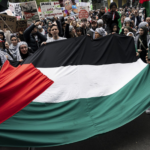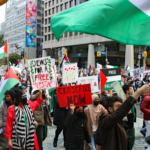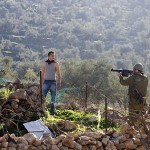Israel’s High-Stake Game in Al-Aqsa and Why Netanyahu May Prevail

Scores of Israeli troops storm al-Aqsa Mosque in Occupied East Jerusalem. (Photo: via Al-Manar)
By Ramzy Baroud
The State of Israel was established on the ruins of Palestine, based on a series of objectives that were named after letters from the Hebrew alphabet, the consequences of which continue to guide Israeli strategies to this day. The current violence against Palestinian worshippers at Al-Aqsa Mosque in Occupied East Jerusalem is a logical extension of the same Zionist ambition.
Plan A (February, 1945), Plan B (May, 1947) and Plan C (November, 1947) all strove to achieve the same end: the ethnic cleansing of Palestine of its original inhabitants. It was not until March 1948 that Plan Dalet (Hebrew for Plan D) brought together all of the preparatory stages for final implementation.
Championed by the Haganah Jewish militias, Plan Dalet led to the destruction of hundreds of villages, the depopulation of entire cities and the defence of the new country’s nominal borders; it also ensured that Palestinian refugees are never allowed back. For Palestinians, that phase of their history is known as the “Nakba”, or the “Catastrophe”.
Dalet was an astounding success from the Zionists’ viewpoint. However, the borders of the state have never been defined, in order to allow for territorial expansion at an opportune moment. That moment arrived when Israel launched its war of 1967 (known to Palestinians as the “Naksa” or “Setback”), seizing East Jerusalem, the West Bank and the Gaza Strip, thus sealing the fate of the whole of historic Palestine.
Occupied Jerusalem was immediately declared to be off-limits to negotiations as Israel’s “historic, eternal and undivided capital”; the Zionist justified this claim by citing or misinterpreting Biblical references as they saw fit. Almost immediately, the Israeli government annexed Jerusalem by extending the West Jerusalem municipal borders to include the newly-conquered Eastern half of the city.
It was not until 1980, though, that Israel passed a law which explicitly annexed the illegally-occupied city to become part of so-called Israel proper. Since then, Jerusalem has been a major point of strife, political conflict and controversy. Understandably, the Jerusalem political discourse is conflated with discussion about religion, but it is far more complex than a conflict over access to holy sites.
The fate of Jerusalem and its holy sites cannot be understood separately from the fate of Palestine itself. And the daily struggle of Palestinian Muslims and Christians in the city is a representation of the struggle of Palestinians everywhere.
As West Jerusalem was conquered under Plan Dalet, East Jerusalem, like the rest of the Occupied Territories was, along with other Palestinian regions, the target of the Allon Plan. This was named after Yigal Allon, a former general and minister in the Israeli government, who took on the task of drawing an Israeli vision for the newly-conquered Palestinian Territories. While the government moved immediately to change the status quo governing East Jerusalem, the Allon Plan sought to annex more than 30 per cent of the West Bank and all of Gaza for “security purposes”.
It stipulated the establishment of a “security corridor” along the River Jordan, as well outside the “Green [1949 Armistice] Line”, a one-sided Israeli demarcation of its borders with the West Bank. The plan envisioned the incorporation of all of the Gaza Strip into Israel, and was meant to return parts of the West Bank to Jordan as a first step toward implementing the “Jordanian option” for Palestinian refugees — in other words, ethnic cleansing — coupled with the creation of an “alternative homeland” on the East Bank of the Jordan for those expelled from their homes.
While the plan was not fully realised, the seizure, ethnic cleansing and annexation of occupied land was a resounding success. Moreover, the Allon Plan provided an unmistakable signal that the Labour government which ruled Israel at the time had every intention of retaining large parts of the West Bank and all of Gaza, with no intention whatsoever of honouring the terms of UN Security Council Resolution 242, which challenged Israel’s military takeover of Palestinian territories.
To ensure that the seizure of new land would be irreversible, the Israeli government needed to move some of its citizens (in violation of the Geneva Conventions) to the newly-occupied territories. Doing so required reaching out to the most reactionary, religious elements of Israeli society, the religious ultra-nationalists, who were on the margins of mainstream politics.
To capitalise on the government’s alluring settlement policies in the West Bank, a group of religious Jews rented a hotel in the Palestinian town of Al-Khalil (Hebron) to spend Passover at the “Cave of the Patriarchs” [the Ibrahimi Mosque], and simply refused to leave. Thus they sparked the passion of religiously Orthodox Israelis across the country, who referred to the West Bank by the Biblical name of Judea and Samaria.
The move ignited the ire of Palestinians, who watched in complete dismay as their land was conquered, renamed and, later, settled by outsiders. In 1970, to “diffuse” the situation, the Israeli government constructed the Kiryat Arba settlement on the outskirts of the Arab city, which invited even more orthodox Jews to move to Al-Khalil.
The Allon Plan may have been intended for strategic purposes, but out of necessity, what began as political objectives intermingled with what became religious and spiritual.
Over the years, the strategic settlement growth was complemented by the religiously-motivated expansion, championed by a vibrant movement, exemplified in the founding of Gush Emunim (Bloc of the Faithful) in 1974. Its mission was to settle legions of fundamentalists on the West Bank.
Little has changed since then, save the fact that the current Israeli administration is a government of settlers, who are not engaged in a symbiotic relationship with governance but who dominate a political establishment that is teeming with zealots and fanatics, relentless on changing the status quo in Jerusalem. They are starting with Haram Al-Sharif, the “Noble Sanctuary”, containing Al-Aqsa Mosque and the Dome of the Rock Mosque.
Although this is one of the holiest Islamic sites in the world, this is not just about religion. Israeli politicians have been “debating” the status of Haram Al-Sharif for many months, as right-wing, religious and ultra-nationalist elements are advocating the complete appropriation of Al-Aqsa Mosque currently under the management of the Ministry of Islamic Waqf (religious endowment).
Israel’s new Minister of Internal Security, Gilad Erdan, is repressing any Palestinian in Jerusalem who dares to challenge new Israeli rules regarding Muslim access to Al-Aqsa. Scores of Palestinians have been shot and beaten, with many more arrested in recent days as they have attempted to confront Israeli police who escort Jewish extremists on their provocative “tours” of the Muslim holy site.
The current conflict suggests a potential repeat of what took place on 25 February, 1994, when a US-born Jewish fanatic, Baruch Goldstein, stormed into the Ibrahimi Mosque in Al-Khalil and opened fire with his Israeli army-issue assault rifle. Over 50 Palestinians were killed while kneeling for morning prayer. In the name of “keeping the peace”, the army took over the mosque and began regulating Muslim access to it, allowing Jewish worshippers to use the Palestinian holy site. Such arrangements have been formalised and today most of the mosque is used as a synagogue, with Muslims excluded. Goldstein and his most ardent supporters hailed from the notorious Kiryat Arba illegal Jewish settlement.
Israeli politicians now want to see the status of Al-Aqsa Mosque changed as well. The government wants to ensure its complete dominance over Palestinians, while the extremists want to demolish the mosque, and build a temple on the site to replace ancient Jewish temples presumably destroyed in 586 BC and AD 70.
However, to change the status of Haram Al-Sharif, which has been an exclusive Muslim site for the past 1,300 years, much blood would have to be spilled. That, too, is being managed by Israel’s Prime Minister, Benjamin Netanyahu, who has successfully persuaded the country’s attorney general to permit the use of sniper fire against protesting Palestinian youth.
With such right-wing and extremist politicians at his side, Netanyahu’s designs in Jerusalem are consistent with the political mood in Israel today, and also consistent with plans enacted by his predecessors many years ago.
The fact that plans to conquer even the remaining symbols of Palestinian nationhood and spirituality have finally reached Al-Aqsa is particularly alarming. Considering the turmoil throughout the Middle East region and the ineffectual Palestinian leadership of Mahmoud Abbas, Netanyahu is likely to push forward with his plan, no matter what the price or the consequences.
– Dr. Ramzy Baroud has been writing about the Middle East for over 20 years. He is an internationally-syndicated columnist, a media consultant, an author of several books and the founder of PalestineChronicle.com. His latest book is My Father Was a Freedom Fighter: Gaza’s Untold Story (Pluto Press, London). His website is: www.ramzybaroud.net.

































0 Comments